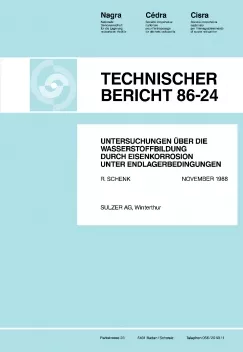
Technischer Bericht NTB 86-24
Untersuchungen über die Wasserstoffbildung durch Eisenkorrosion unter Endlagerbedingungen
Cast steel (GS-40) is being evaluated as a potential material for high-level waste canisters; in a repository environment, these canisters will be required to isolate the vitrified waste from contact with the groundwater for at least 1000 years. Corrosion studies to date have indicated that the behaviour of the unalloyed steel is suitable in this respect.
If, in the absence of oxygen (anaerobic repository), water is the only oxidising agent present, the corrosion rate of unalloyed steel can drop to the order of 1 micrometer / year (1μm·a-1) or <0.1μm·a-1; metal loss is therefore negligible in this situation. Interest is in this case focussed on the corrosion products:
- hydrogen, which is produced in equivalent proportions to corroded iron according to the equation Fe + 2 H2O → Fe(OH)2 + H2 and must be taken into consideration in repository safety analysis.
- iron oxides and salts in the form of passive films or protective layers which can promote low corrosion rates.
In this study, gas chromatography was used to measure hydrogen formation to 0.01 millilitres (STP) per square metre of iron surface per hour (0.01 ml(H2)·m-2·h-1) and corrosion rates to 0.04 μm·a-1.
In addition to the reference groundwaters from Böttstein and Säckingen, steel samples were tested in media with varying Cl--content and pH value at different temperatures.
Five different corrosion reactions were identified for the range of media used:
- Formation of high-quality protective layers with average corrosion rates of -1 and 2)·m-2·h-1. The waters from Säckingen and Böttstein belong to this reaction type.
- Low-quality protective layers with somewhat higher corrosion rates.
- Passivity following an initial phase with active corrosion.
- Permanent passivity with corrosion rates partly below the detection limit of 0.04 μm·a-1 and 0.02 ml (H2)·m-2·a-1. As a matter of interest, test variants with a high Cl--content fall into this category, e.g. 8000 ppm Cl- at 50°C and pH 10.
- Unstable passivity: basically low corrosion rates (-1) rise temporarily to significantly higher values. The reason could be macro- or local elements, depending on the corrosion medium.
As expected, as the alkalinity increases, the media tend towards passive corrosion rather than formation of protective layers. Particularly in the case of intermediate Cl--contents, unstable passivity can apparently occur as an intermediate stage. Conditioning of the immediate vicinity of the canister should take account of the need to maintain a stable, quantifiable corrosion system.
